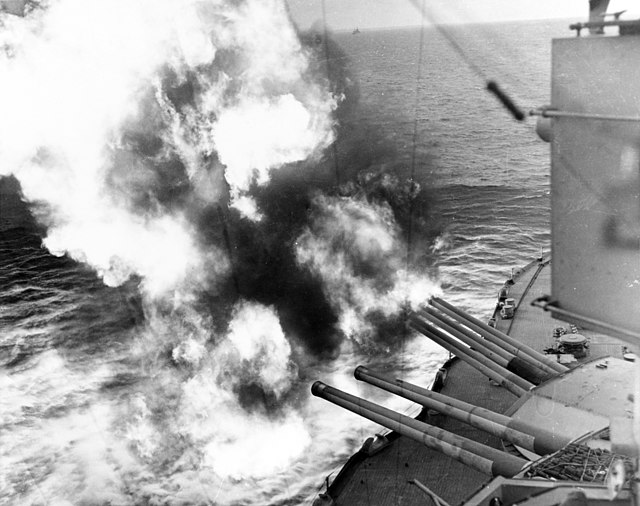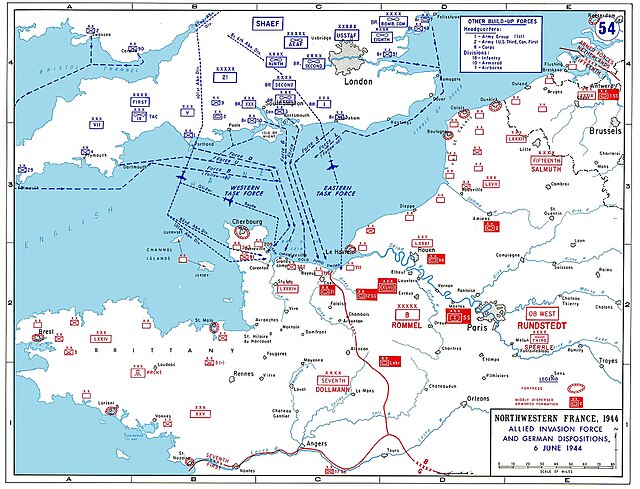Utah Beach
Utah, commonly known as Utah Beach, was the code name for one of the five sectors of the Allied invasion of German-occupied France in the Normandy landings on June 6, 1944 (D-Day), during World War II. The westernmost of the five code-named landing beaches in Normandy, Utah is on the Cotentin Peninsula, west of the mouths of the Douve and Vire rivers. Amphibious landings at Utah were undertaken by United States Army troops, with sea transport, mine sweeping, and a naval bombardment force provided by the United States Navy and Coast Guard as well as elements from the British, Dutch and other Allied navies.
The objective at Utah was to secure a beachhead on the Cotentin Peninsula, the location of important port facilities at Cherbourg. The amphibious assault, primarily by the US 4th Infantry Division and 70th Tank Battalion, was supported by airborne landings of the 82nd and 101st Airborne Division. The intention was to rapidly seal off the Cotentin Peninsula, prevent the Germans from reinforcing Cherbourg, and capture the port as quickly as possible. Utah, along with Sword on the eastern flank, was added to the invasion plan in December 1943. These changes doubled the frontage of the invasion and necessitated a month-long delay so that additional landing craft and personnel could be assembled in England. Allied forces attacking Utah faced two battalions of the 919th Grenadier Regiment, part of the 709th Static Infantry Division. While improvements to fortifications had been undertaken under the leadership of Field Marshal Erwin Rommel beginning in October 1943, the troops assigned to defend the area were mostly poorly equipped non-German conscripts.
D-Day at Utah began at 01:30, when the first of the airborne units arrived, tasked with securing the key crossroads at Sainte-Mère-Église and controlling the causeways through the flooded farmland behind Utah so the infantry could advance inland. While some airborne objectives were quickly met, many paratroopers landed far from their drop zones and were unable to fulfill their objectives on the first day. On the beach itself, infantry and tanks landed in four waves beginning at 06:30 and quickly secured the immediate area with minimal casualties. Meanwhile, engineers set to work clearing the area of obstacles and mines, and additional waves of reinforcements continued to arrive. At the close of D-Day, Allied forces had only captured about half of the planned area and contingents of German defenders remained, but the beachhead was secure.
The 4th Infantry Division landed 21,000 troops on Utah at the cost of only 197 casualties. Airborne troops arriving by parachute and glider numbered an additional 14,000 men, with 2,500 casualties. Around 700 men were lost in engineering units, 70th Tank Battalion, and seaborne vessels sunk by the enemy. German losses are unknown. Cherbourg was captured on June 26, but by this time the Germans had destroyed the port facilities, which were not brought back into full operation until September.
-
1
Allied planning
- 1.1 Plan of attack
- 2 German preparations
-
3
D-Day (June 6, 1944)
- 3.1 Landing
- 3.2 Moving inland
- 4 Result
- 5 Units
- 6 Maps
- 7 See also
- 8 References
- 9 Sources
- 10 Further reading
- 11 External links
Links
Images Gallery
-

-

-
 Utah landings, planned (center/right) and actual (left). North: lower right
Utah landings, planned (center/right) and actual (left). North: lower right
-

-

-

-
 Nevada fires upon shore.
Nevada fires upon shore.
-
 C-47 Skytrains with paratroops above a landing craft.
C-47 Skytrains with paratroops above a landing craft.
-
 Map of the invasion area showing channels cleared of mines, location of vessels engaged in bombardment, and targets on shore. Utah is the westernmost landing area.
Map of the invasion area showing channels cleared of mines, location of vessels engaged in bombardment, and targets on shore. Utah is the westernmost landing area.
-
 German prisoners of war in an enclosure on Utah.
German prisoners of war in an enclosure on Utah.
-
 Gliders are delivered to the Cotentin Peninsula during Mission Elmira.
Gliders are delivered to the Cotentin Peninsula during Mission Elmira.
-
 Members of the 101st Airborne Division in the village of St. Marcouf, June 8, 1944
Members of the 101st Airborne Division in the village of St. Marcouf, June 8, 1944
-

-

-

-

-

-

-

-

-

-

-

-

-

-
-

-

-

Comments
Share your experience with others and write the first comment about the location




























